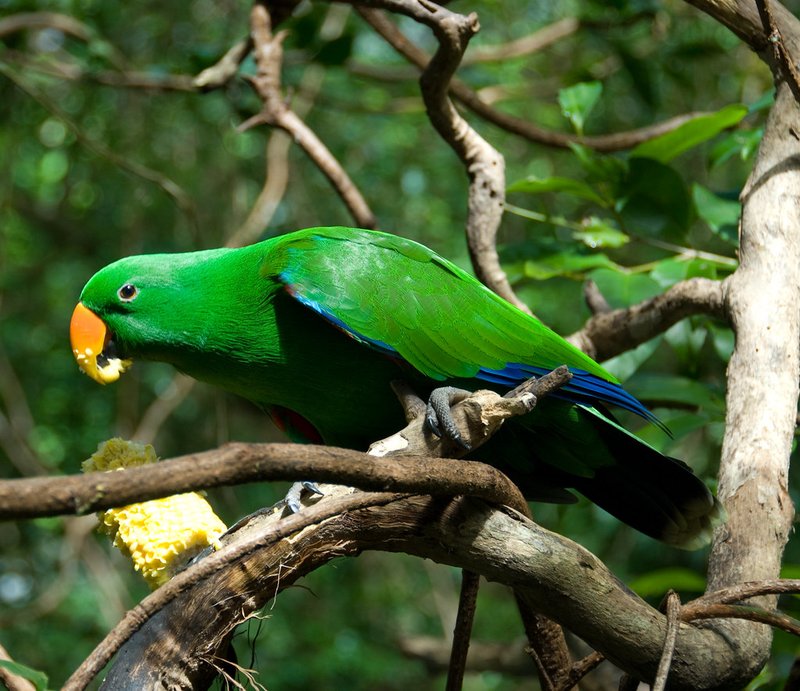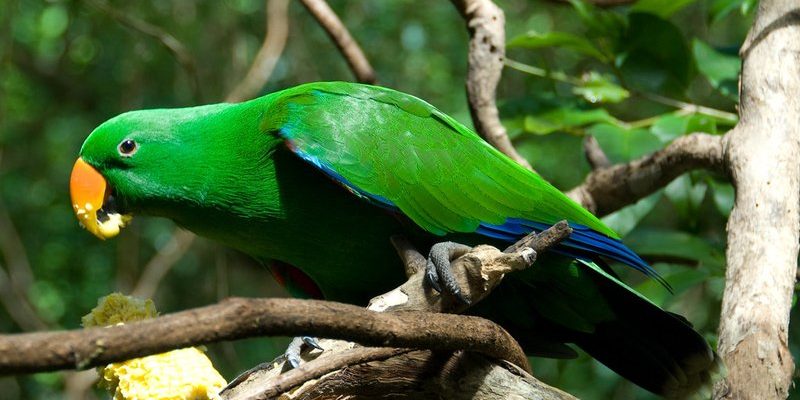
Imagine trekking through lush greenery, the air thick with the scent of exotic plants. Suddenly, a flash of green and red catches your eye. Is it just a leaf, or is it something more? If you suspect it might be an Eclectus parrot, you’re in for a treat. These birds have distinct traits that make them easier to recognize, and by learning a few key details, you’ll be well-prepared to spot them in their natural habitat.
Understanding the Eclectus Parrot’s Appearance
The first thing to note about Eclectus parrots is their stunning coloration. The males are a vibrant green, which helps them blend into the rainforest canopy. They have striking red and blue underwing feathers, which become more apparent when they take flight. On the other hand, the females are known for their rich crimson red plumage accented by purple and blue highlights. This sexual dimorphism—where males and females look significantly different—makes it easier to identify each sex just by color.
But color isn’t everything. Pay attention to their size and shape as well. Eclectus parrots are medium-sized, measuring about 12 to 14 inches long. They have a sturdy body and a strong, curved beak that’s yellow or orange at the base. Honestly, if you think you’ve spotted one, take a moment to observe how it moves. Eclectus parrots are known for their graceful movements, often hanging upside down or swaying gently from branch to branch.
In addition to their vibrant plumage, look for their distinctive behaviors. These parrots are curious and social creatures, often seen foraging in pairs or small groups. If you hear soft whistling or chattering sounds, it might just be a clue that Eclectus parrots are nearby. You might be wondering how to differentiate their calls from other birds—well, their voices are relatively soft compared to the raucous squawks of many other parrots.
Listening for Their Unique Calls
The Eclectus parrot has a range of vocalizations that might just give away their presence before you even see them. Their calls can be described as soft, melodic whistles or quiet murmurs, unlike the louder, harsher calls of many other species. This is where you can really tune into your surroundings. If you hear gentle sounds echoing in the trees, take it as your cue to look a little closer.
It’s interesting how birdcalls create a sort of conversation in the wild. Male Eclectus parrots tend to have a lower pitch, while females may chirp in a higher tone. This slight difference can help you distinguish between the two genders, even without seeing them. If you’re lucky enough to hear a pair communicating, you’ll witness the bond these parrots share—something that makes their observation all the more rewarding.
Now, you might wonder how often these birds call out. Typically, they vocalize more in the morning and late afternoon as they settle down for the night or wake up to start their day. If you’re walking through the forest at these times, keep your ears open. You could be in for an enchanting experience!
Where to Look for Eclectus Parrots
Knowing where to find Eclectus parrots can significantly enhance your chances of spotting them. Their preferred habitat includes tropical rainforests and wooded areas. They thrive in regions where they can find plenty of fruit, seeds, and nuts, which are staples in their diet. If you’re on a nature trek, look for these birds in areas rich with fruit-bearing trees, as this is where they spend a lot of their time foraging.
When exploring their natural habitat, remember that these parrots are often found at higher altitudes. They tend to perch among tree branches, where the dense foliage provides them with cover. Keep an eye on the treetops and listen for rustling sounds, which might indicate their presence. Honestly, spotting them from a distance can be tricky, but if you focus on movement and sound, you’ll improve your chances.
Another good spot to look for them is near water sources. Eclectus parrots, like many other bird species, need to hydrate, so you may find them near rivers or streams, especially in the mornings when they come out to drink. Just like humans, they love to socialize around a refreshing spot, so it’s a great place to see them interacting.
Observing Their Feeding Habits
One of the most enjoyable aspects of watching Eclectus parrots is observing their feeding habits. These parrots have a unique diet mainly consisting of fruits, seeds, and even flowers. If you notice them foraging, it’s a delightful sight—they nibble and pick at various fruits, using their strong beaks to peel away tough skins and extract juicy morsels.
When they’re feeding, you might see them hanging upside down or perched on a branch, maneuvering skillfully for the best bites. Their feeding behavior can be fascinating to watch, as they often engage in playful antics with one another, tugging at branches and hopping around. Honestly, this playful nature adds a layer of charm to their already vivid personalities.
If you’re trying to spot them while they eat, look for trees with bright fruits like papayas or figs. They seem to have favorites, and if you find the right tree, you might just catch a group enjoying a feast. You could spend hours enjoying their antics and beautiful colors as they contrast against the lush greens of their surroundings.
Recognizing Their Behavior and Social Structure
Eclectus parrots are highly social animals, often found in pairs or small flocks. They communicate with each other through a variety of calls and body language. If you see a group, pay attention to how they interact. They might be grooming one another, which is a sign of bonding, or they might be playfully chasing each other through the trees.
During breeding season, which typically occurs between May and September, you might observe males showing off for females. They’ll display their bright colors and call out melodiously, trying to attract a mate. This sight can be quite special, as these birds put on quite a show to impress the opposite sex. You might be surprised at how much personality they exhibit during these moments.
Furthermore, Eclectus parrots are known for their intelligence. They can solve problems and even mimic sounds from their environment, making them fascinating creatures to study. If you see one interacting with its surroundings, like manipulating branches or discovering new food sources, take a moment to appreciate their cleverness. It’s these little behaviors that offer a glimpse into their rich social lives.
Respecting Their Habitat
While it’s thrilling to identify an Eclectus parrot in the wild, it’s crucial to remember the importance of respecting their habitat. These birds face threats from habitat destruction, so being a responsible observer is essential. Keep a safe distance—your goal is to enjoy the sight without disturbing them or their environment.
If you’re hiking in a region where they live, stick to marked trails. This practice helps protect the natural resources and animals that call these areas home. Taking care not to litter or leave behind any waste is another way to show your respect for their habitat. Every small action counts!
Additionally, if you have the opportunity to connect with local conservation groups or birdwatching communities, do so. Engaging with others who are passionate about protecting wildlife can enhance your experience while learning more about the challenges these beautiful creatures face.
Why Identifying Eclectus Parrots Matters
Understanding how to identify Eclectus parrots in the wild goes beyond just spotting a pretty bird. It’s about appreciating the diversity of our planet’s ecosystems and recognizing the role these parrots play in the environment. They help with seed dispersal, contributing to the regeneration of forests.
By learning to identify them, you join a community of birdwatchers and nature enthusiasts who care about and advocate for wildlife conservation. Every sighting can help increase awareness and promote the need to protect their natural habitats from threats like deforestation and pollution.
In conclusion, spotting an Eclectus parrot in the wild is like finding a colorful treasure. By familiarizing yourself with their appearance, calls, feeding habits, and social behaviors, you increase your chances of witnessing these magnificent birds. And remember, while you’re out there, respect their space and play your part in protecting their habitat. Nature is a shared experience, and every little effort helps preserve its beauty for future generations to enjoy.

